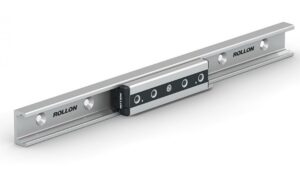1. Introduction to Linear Motion Guides
2. How Does a Linear Motion Guide Work?
Guide Rail (Track)– A rigid, precision-machined rail that provides the linear path. Carriage (Slider/Block)– A moving component that holds the bearing systemand attaches to the load. Bearings (Rolling or Sliding Elements)– Reduce friction between the carriage and rail, enabling smooth motion.
Key Motion Mechanisms:
Rolling Motion (Ball or Roller Bearings)– Provides low friction, high speed, and precision(most common). Sliding Motion (Bushings or Sleeve Bearings)– Simpler, lower-cost but higher friction (used in light-duty applications).
3. Types of Linear Motion Guides
(1) Based on Bearing Type
(2) Based on Rail & Carriage Design
Profiled Rail Guides (Square Rails)– High rigidity, precision, and load capacity (used in CNCs). Round Rail Guides (Shaft-Based)– More flexible, easier to install (used in 3D printers, light automation). Miniature Linear Guides– Compact, used in medical devices and precision instruments.
(3) Based on Precision Grade
Standard Precision– General automation, light loads. High Precision (H-grade)– CNC machines, high-accuracy applications. Ultra-High Precision (P-grade)– Semiconductor manufacturing, metrology.
4. Key Components of a Linear Motion Guide
(1) Guide Rail (Track)
Made of hardened steel (often chrome-plated or stainless steel). Precision-ground for straightness and surface finish. Available in square (profiled) or round (shaft) configurations.
(2) Carriage (Slider/Block)
Houses the bearing balls/rollers. May include preloaded bearingsfor zero backlash. Attached to the moving part of the machine.
(3) Bearings (Rolling Elements)
Ball Bearings (Most Common)– Low friction, high speed. Roller Bearings– Higher load capacity. Recirculating Bearings– Allow continuous motion over long distances.
5. Advantages of Linear Motion Guides
6. Disadvantages & Limitations
7. Applications of Linear Motion Guides
8. How to Select the Right Linear Motion Guide
Load Requirements(Radial, Axial, Moment Loads) Travel Distance & Speed Environmental Conditions(Dust, Moisture, Temperature) Precision Needs(Standard vs. High Precision) Mounting Space & Installation Constraints
Rail/Rod Diameter(6mm to 50mm+ common) Rail Length(Customizable) Carriage Size & Load Rating Accuracy Class (H, P, etc.) Lubrication Type (Oil, Grease, Maintenance-Free)
9. Installation & Maintenance Tips
Installation Best Practices
Maintenance Guidelines
10. Linear Motion Guide vs. Linear Guide Shaft vs. Linear Rail
11. Conclusion: Why Linear Motion Guides Are Essential
Key Takeaways:
Ball guidesare best for precision and speed. Roller guidesare ideal for heavy loads. Slide guidesare suitable for simple, low-cost applications. Proper installation and maintenanceextend lifespan.
Need Help Choosing a Linear Motion Guide?
Load requirements(static/dynamic) Precision needs(micron-level vs. general use) Environment(dust, moisture, temperature)
wang, tingting




